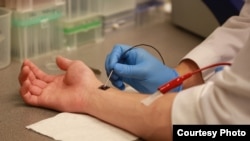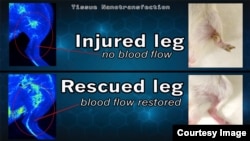Researchers have turned skin cells into blood vessel tissue to save a mouse's wounded leg. They were able to do that simply by tapping the wound with a chip that uses nanotechnology to inject new DNA into the cells.
This step follows a number of significant advances in techniques to turn one type of cell into another. Scientists hope this so-called cell reprogramming can one day be used to regenerate damaged tissue, or cure conditions such as Parkinson's disease.
The research, published Monday in Nature Nanotechnology, combines existing biotechnology and nanotechnology to create a new technique called tissue nano-transfection. The researchers turned skin cells into brain cells, in addition to demonstrating the therapeutic benefit of turning them into vascular cells.
Maintaining blood flow to deliver nutrients around a wound is critical for recovery, so by making more blood vessel cells, researchers found that a mouse's wounded limb was more likely to survive.
A brief electric current causes the chip to eject DNA fragments that reprogram the cells. The particles only enter the very top layer of cells, so L. James Lee, a biomolecular engineer at Ohio State University and study co-author, said he was surprised to find reprogrammed cells deep within the tissue.
"Within 24 hours after the transfection, we actually observed the propagation of the biological functions deep inside the skin," Lee told VOA. "So we were very surprised that it actually works for tissue." Lee said it wasn't yet entirely clear why this was possible.
Masato Nakafuku, who studies cell reprogramming at the University of Cincinnati and was not associated with the research, told VOA that he, too, was surprised "to see very efficient generation of the [vascular] cells."
Nakafuku added a cautionary note: It is not clear that that tissue nano-transfection will work on animals as large as humans, since the treatment would have to reprogram cells much deeper in the tissue in order to be effective.
Lee told VOA he is hopeful that upcoming human trials will prove the real-world effectiveness of tissue nano-transfection.
In theory, tissue nano-transfection should be able to turn any cell in the body into any other cell type. That could make therapeutic applications of cell reprogramming easier and safer, because cells would stay in the body during reprogramming. If cells are removed from the body, reprogrammed and then returned, they could be attacked by the immune system.









